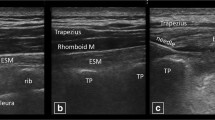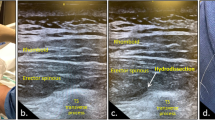Abstract
Purpose of Review
The erector spinae plane block (ESPB), first described in 2016, offers the promise of becoming a safe, less invasive, and technically less demanding alternative to conventional thoracic regional anesthetic techniques including thoracic epidurals and traditional paravertebral blocks. Clinical and cadaveric studies suggest that ESPB acts on the ventral rami of spinal nerves in the paravertebral space via penetration of the intertransverse connection tissues and moreover achieves visceral analgesia via the rami communicantes and sympathetic chain.
Recent Findings
The block has garnered considerable appeal related to an inherently lower risk of neurovascular and pleural injury, low risk of local anesthetic systemic toxicity, and relative technical simplicity in comparison with epidural or paravertebral blockade. It has been utilized in the treatment of acute perioperative pain in a variety of clinical applications including breast, thoracic, and abdominal surgeries and trauma and may even offer some benefit in spine surgery.
Summary
Given the combination of its efficacy and decreased associated risk when performed for perioperative pain, use of ESPB should be further explored for the management of chronic pain. Current literature at this time is limited to case studies and series performed by select groups. Though it is important to consider ESPB for chronic pain, further studies are needed to evaluate the efficacy and safety of the ESPB in the management of both acute and chronic pain.
Similar content being viewed by others
References
Papers of particular interest, published recently, have been highlighted as: • Of importance
El-Boghdadly K, Pawa A. The erector spinae plane block: plane and simple. Anaesthesia. 2017;72:434–8.
Forero M, Adhikary SD, Lopez H, Tsui C, Chin KJ. The erector spinae plane block a novel analgesic technique in thoracic neuropathic pain. Reg Anesth Pain Med. 2016;41:621–7.
• Ivanusic J, Konishi Y, Barrington MJ. A cadaveric study investigating the mechanism of action of erector spinae blockade. Reg Anesth Pain Med. 2018;43:567–71 A cadaveric investigation describing the mechanism of the ESPB.
Adhikary SD, Bernard S, Lopez H, Chin KJ. Erector spinae plane block versus retrolaminar block. Reg Anesth Pain Med. 2018;43:756–62.
• Schwartzmann A, Peng P, Maciel MA, Forero M. Mechanism of the erector spinae plane block: insights from a magnetic resonance imaging study. Can J Anesth Can d’anesthésie. Springer US; 2018;65:1165–6. A radiographic investigation describing the mechanism of the ESPB.
• Fusco P, Dicarlo S, Scimia P, Luciani A, Petrucci E, Marinangeli F. Could the new ultrasound-guided erector spinae plane block be a valid alternative to paravertebral block in chronic chest pain syndromes? Minerva Anestesiol. 2017;83:1112–3 A study to assess the ESPB as an alternative to paravertebral blocks in chronic pain.
Hamilton DL. Pneumothorax following erector spinae plane block. J Clin Anesth. Elsevier; 2018;52:17.
Bonvicini D, Tagliapietra L, Giacomazzi A, Pizzirani E. Bilateral ultrasound-guided erector spinae plane blocks in breast cancer and reconstruction surgery. J Clin Anesth.. Elsevier Inc; 2018;44:3–4.
Ueshima H, Otake H. Limitations of the erector spinae plane (ESP) block for radical mastectomy. J Clin Anesth. Elsevier; 2018;51:97.
Hamilton DL, Manickam B. Erector spinae plane block for pain relief in rib fractures. Br J Anaesth. The Author(s); 2017;118:474–5.
Takahashi H, Suzuki T. Erector spinae plane block for low back pain in failed back surgery syndrome : a case report. JA Clin Rep. 2018:6–9.
Chin KJ, Malhas L, Perlas A. The erector spinae plane block provides visceral abdominal analgesia in bariatric surgery a report of 3 cases. Reg Anesth Pain Med. 2017;42:372–6.
Kim E, Kwon W, Oh S, Bang S. The erector spinae plane block for postoperative analgesia after percutaneous nephrolithotomy. Chin Med J. 2018;131:1877–8.
Forero M, Rajarathinam M, Adhikary S, Chin KJ. Erector spinae plane (ESP) block in the management of post thoracotomy pain syndrome: a case series. Scand J Pain. Elsevier B.V.; 2017;17:325–9.
Ahiskalioglu A, Alici HA, Ciftci B, Celik M, Karaca O. Continuous ultrasound guided erector spinae plane block for the management of chronic pain. Anaesth Crit Care Pain Med. Société française d’anesthésie et de réanimation (Sfar); 2018;2017–8.
Forero M, Rajarathinam M, Adhikary SD, Chin KJ. Erector spinae plane block for the management of chronic shoulder pain: a case report. Can J Anesth Can d’anesthésie. Springer US; 2017;65:288–93.
Ueshima H, Otake H. Erector spinae plane block for pain management of wide post-herpetic neuralgia. J Clin Anesth. Elsevier; 2018;51:37.
Melvin J, Schrot R, Chu G, Chin K. Low thoracic erector spinae plane block for perioperative analgesia in lumbosacral spine surgery: a case series. Can J Anaesth. 2018;65:1057–65.
Author information
Authors and Affiliations
Corresponding author
Ethics declarations
Conflict of Interest
Ivan Urits, Kyle Gress, Karina Charipova, Patrick Laughlin, Vwaire Orhurhu, and Omar Viswanath declare no conflict of interest. Alan D. Kaye discloses that he is on the Speakers Bureau for Depomed, Inc. and Merck.
Human and Animal Rights and Informed Consent
This article does not contain any studies with human or animal subjects performed by any of the authors.
Additional information
Publisher’s Note
Springer Nature remains neutral with regard to jurisdictional claims in published maps and institutional affiliations.
This article is part of the Topical Collection on Hot Topics in Pain and Headache
Rights and permissions
About this article
Cite this article
Urits, I., Charipova, K., Gress, K. et al. Expanding Role of the Erector Spinae Plane Block for Postoperative and Chronic Pain Management. Curr Pain Headache Rep 23, 71 (2019). https://doi.org/10.1007/s11916-019-0812-y
Published:
DOI: https://doi.org/10.1007/s11916-019-0812-y




